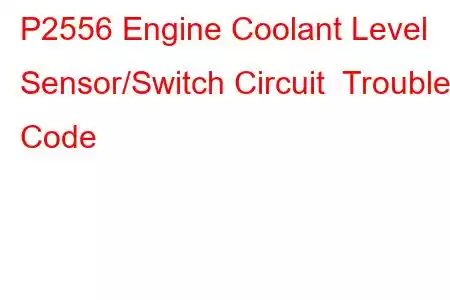P2556 Engine Coolant Level Sensor/Switch Circuit
OBD-II Trouble Code Technical Description
Engine Coolant Level Sensor/Switch Circuit
What does that mean?
This is a generic powertrain diagnostic trouble code (DTC) and applies to many OBD-II vehicles (1996-newer). That may include but is not limited to vehicles from Audi, Ford, BMW, Lincoln, Chrysler, etc. Although generic, the exact repair steps may vary depending on year, make, model and powertrain configuration.
OBD-II trouble code P2556 and related codes P2557, P2558 and P2559 are associated with the engine coolant level sensor and/or switch circuit.
Some vehicles are equipped with a coolant level sensor or switch. Typically it operates by using a float of some kind, similar to what your gas gauge sending unit uses. If the coolant level drops below a specific level, that completes the circuit and tells the PCM (powertrain control module) to set this code.
When the PCM detects improper voltage or resistance within the engine coolant level sensor/switch circuit, code P2556 will be set and the check engine or low coolant / overheating light may be illuminated.
What is the severity of this DTC?
The severity of this code is moderate because if the engine coolant level drops too low there is potential for the engine to overheat and cause extensive damage.
What are some of the symptoms of the code?
Symptoms of a P2556 trouble code may include:
Cooling system warning lamp illuminated Check engine light illuminatedWhat are some of the common causes of the code?
Causes for this P2556 code may include:
Defective coolant level sensor or switch Open or short in circuit Faulty or damaged wiring Corroded, damaged or loose connector Defective fuse or fuse-able link (if applicable) Defective PCMWhat are some P2556 troubleshooting steps?
The first step in the troubleshooting process for any malfunction is to research the Technical Service Bulletins (TSB's) for the specific vehicle by year, model and engine/transmission configuration. In some circumstances, this can save a lot of time in the long run by pointing you in the right direction.
The second step is to locate all components associated with the engine coolant level circuit and look for obvious physical damage. Possible locations for this sensor or switch may include the coolant reservoir or overflow bottle, or the radiator. Refer to a vehicle specific repair manual to determine the location in your vehicle.
Perform a thorough visual inspection to check the associated wiring for obvious defects such as scraping, rubbing, bare wires, or burn spots. Next is to check the connectors and connections for security, corrosion and damaged pins. This process must include all wiring connectors and connections to all components including the PCM. Consult the specific tech data for the vehicle to verify the configuration of the oil level safety circuit and see if a fuse or fuse-able link is incorporated into the circuit.
Advanced Steps
The advanced steps become very vehicle specific and require the appropriate advanced equipment to perform accurately. These procedures require a digital multimeter and the specific technical references for the vehicle. In this situation, an oil pressure gauge may facilitate the troubleshooting process.
This article is strictly informational and the specific technical data and service bulletins for your vehicle should always take priority.
Read: 22


